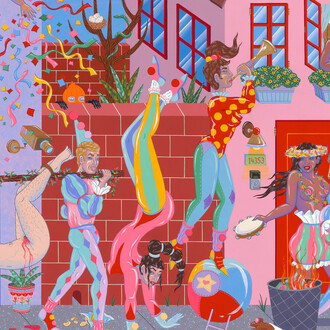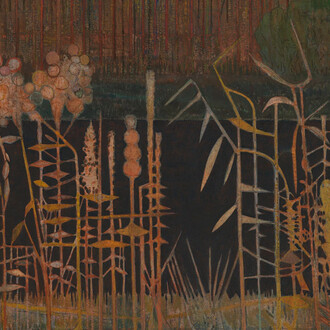David Zwirner is pleased to announce an exhibition of works by American artist John McCracken at the gallery’s 616 North Western Avenue location in Los Angeles, presented on the ninetieth anniversary of his birth. Featuring a selection of the artist’s signature planks and columns installed in the round, this will be the first solo presentation in more than twenty years in a city he long called home and with which he was intimately associated. In bringing together two of his most enduring sculptural forms, the exhibition will illuminate the artist’s nuanced modulation of color, shape, and surface that extended throughout his more than five-decade-long career.
McCracken developed his early sculptural work while studying painting at the California College of Arts and Crafts in Oakland in the late 1950s and early 1960s. While experimenting with increasingly three-dimensional canvases, the artist began to create objects made with industrial materials, including plywood, sprayed lacquer, and pigmented resin, resulting in the highly reflective, smooth surfaces for which he would become known. As he described his practice, “In distilling my ideas I was doing something analogous to making poetry—trying, in a way, to say the most with the least.”
McCracken relocated to LA in the late 1960s and remained a fixture of the burgeoning art scene there through the early 1990s when he moved to Santa Fe, where he would remain for the rest of his life. His work—which has been uniquely influential to subsequent generations of artists—came to represent a distinctively West Coast take on the ascendant minimalist aesthetic coming out of New York in those years. In opposition to the industrially produced, non-referential objects that their East Coast peers were making, McCracken and his contemporaries offered sculptures made from synthetic materials, such as plastic and fiberglass, and highly finished surfaces, often in combination with light and luminescent shades of color that brought to mind the vivid California sun, LA’s vibrant culture of cars and surfboards, and a multitude of other points of reference.
Though sleek in their highly glossed appearance, McCracken’s geometric forms were handcrafted, meticulously constructed from plywood coated with fiberglass and layers of pigmented polyester resin, taken to such a high polish that they partly reflect the world around them. These works, in particular his planks and columns, exemplify McCracken’s long-standing interest in the transcendent potential of minimalist abstraction and its allowance for myriad readings and associations. As curator Robin Clark describes:
Often vibrantly hued or glossy black, these objects appear from some angles to be blunt forms, while from other points of view the polished surfaces mirror their surroundings, causing the sculptures to appear ghostly or transparent. This paradox, and the suggestion of entertaining multiple realities simultaneously, is central to McCracken’s practice.
The exhibition will include a selection of planks in varying colors and sizes that span the artist’s career. Developed in 1966, the plank became his signature sculptural form: a narrow, rectangular board format that leans at an angle against the wall—the traditional site of painting—while simultaneously entering into the three-dimensional realm and physical space of the viewer. For the artist, this format was multivalent, alternately functioning as a gateway to other worlds, a spiritual self-portrait, or simply just a pleasing object to be admired. Color was an integral element of McCracken’s practice, particularly evident in his body of planks. The artist mixed the color of each of these works by hand, keeping careful notes on his recipes which he felt were successful. The majority of his planks were made in a monochromatic finish, and the artist considered similar or even identical forms executed in differing hues to be entirely individuated artworks that engage with their surroundings distinctly. He wrote in 1966:
I think of color as being the structural material I use to build the forms I am interested in.… I have found that a certain range of mainly primary and secondary colors and a certain combination of color intensity transparency and surface finish provide me with the expressive means I want.
Likewise, McCracken’s columns—strong vertical forms that come in part out of the artist’s interest in ancient Greek and Egyptian architecture—explore the phenomenological relationship between work, viewer, and architecture through their outsized stature. On view will be a grouping of rectangular as well as faceted forms that conjure a range of everyday and otherworldly associations. With each column standing around eight feet in height, viewers can see themselves and their surroundings fully reflected in these surfaces. Simultaneously earthbound and ethereal, these works—like many of McCracken’s sculptures—offer viewers an experience that both grounds them where they are and offers vast, open worlds.
Beginning in the 1960s, John McCracken (1934–2011) exhibited steadily in the United States and abroad, and his early work was included in groundbreaking exhibitions such as Primary Structures at the Jewish Museum, New York (1966), and American Sculpture of the Sixties at the Los Angeles County Museum of Art (1967). In 1986, the major survey Heroic Stance: The Sculpture of John McCracken 1965–1986 was organized by P.S.1 Contemporary Art Center, New York, and traveled to the Newport Harbor Art Museum (now the Orange County Museum of Art), Newport Beach, California; Fine Arts Gallery, University of California, Irvine; and the Contemporary Arts Museum Houston. In 2011, his work was the subject of a large-scale retrospective at Castello di Rivoli, Turin. Other significant solo shows include those hosted by the Hochschule für Angewandte Kunst, Vienna (1995); Kunsthalle Basel (1995);
McCracken’s work has been prominently featured in major group exhibitions worldwide, including A Minimal Future? Art as Object 1958–1968, The Museum of Contemporary Art, Los Angeles (2004); The Los Angeles Art Scene, 1955–1985, Centre Georges Pompidou, Paris (2006); Documenta 12, Kassel, Germany (2007); and Time & Place: Los Angeles 1957–1968, Moderna Museet, Stockholm (2008). Additionally, the artist’s work was in three shows organized as part of the 2011 region-wide initiative Pacific Standard Time: Art in L.A. 1945–1980 at the Getty Center, Los Angeles; Museum of Contemporary Art San Diego, La Jolla, California; and Pomona College Museum of Art, Claremont, California.
Work by the artist is held in prominent international collections, including the Art Gallery of Ontario, Toronto; Art Institute of Chicago; Castello di Rivoli, Turin; Los Angeles County Museum of Art; Musée d’art contemporain de Montréal; Musée d’art moderne et contemporain, Geneva; The Museum of Contemporary Art, Los Angeles; The Museum of Modern Art, New York; Orange County Museum of Art, Newport Harbor, California; Palais des Beaux-Arts, Brussels; San Francisco Museum of Modern Art; Solomon R. Guggenheim Museum, New York; and the Whitney Museum of American Art, New York.
McCracken joined David Zwirner in 1997. During his lifetime, the artist had seven solo exhibitions with the gallery in New York, including Sculpture (1997); Stainless Steel Sculptures (2000); Early Sculpture (2005); and New Works in Bronze and Steel (2010), among others. In 2013, Works from 1963–2011, on view at the West 20th Street location in New York, marked the gallery’s most comprehensive presentation to date of the artist’s work. In 2017, David Zwirner presented a solo exhibition in New York of key examples from three discrete groups of McCracken’s work—leaning multipart wall pieces, wall-mounted multipart reliefs, and freestanding columns. The two-person exhibition, William Eggleston and John McCracken: True Stories, was on view at David Zwirner, New York, in 2021.
















